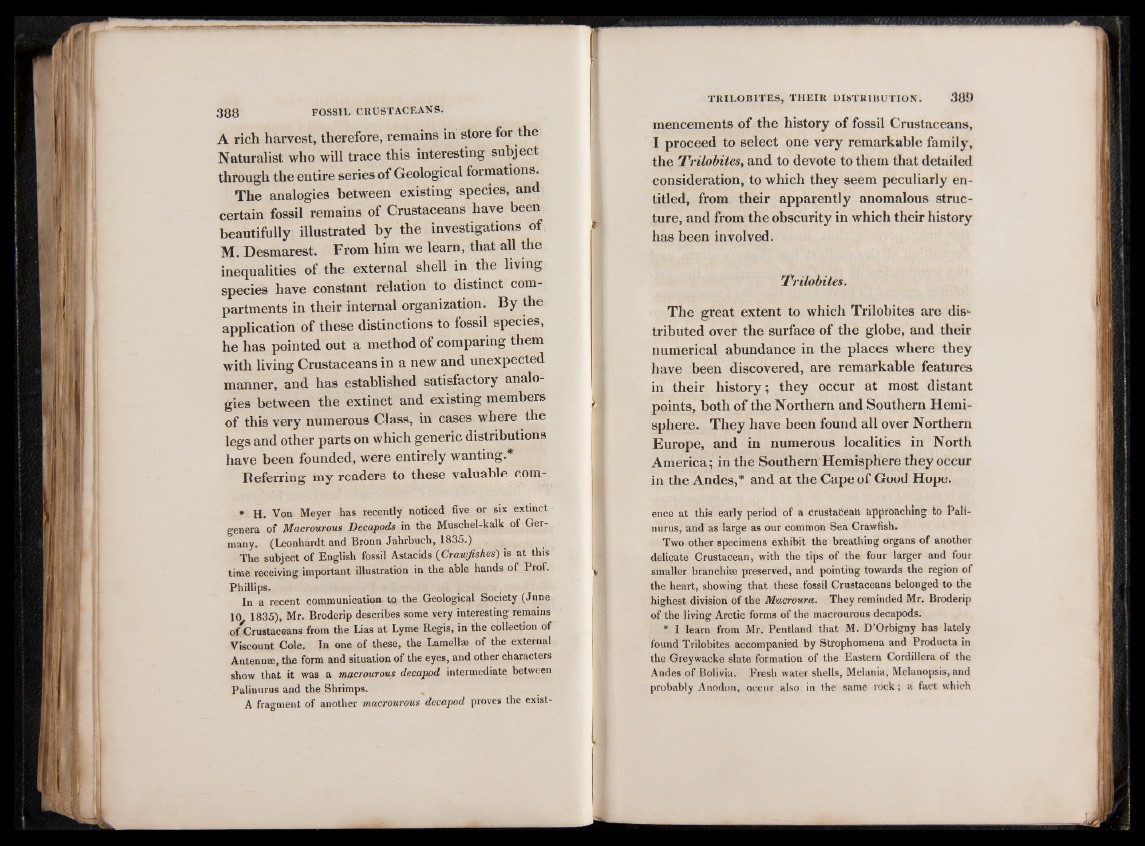
A rich harvest, therefore, remains in store for the
Naturalist who will trace this interesting subject
through the entire series of Geological formations.
The analogies between existing species, and
certain fossil remains of Crustaceans have been
beautifully illustrated by the investigations of
M. Desmarest. From him we learn, that all the
inequalities of the external shell in the living
species have constant relation to distinct compartments
in their internal organization. By the
application of these distinctions to fossil species,
he has pointed out a method of comparing them
with living Crustaceans in a new and unexpected
manner, and has established satisfactory analogies
between the extinct and existing members
of this very numerous Class, in cases where the
legs and other parts on which generic distributions
have been founded, were entirely wanting.*
Referring my readers to these valuable com-
* H. Von Meyer has recently noticed five or six extinct
genera of Macrourous Decapods in the Muschel-kalk of Germany.
(Leonhardt and Bronn Jahrbuch, 1835.)
The subject of English fossil Astacids ( Crawfishes) is at this
time receiving important illustration in the able hands o f Prof.
Phillips.
In a recent communication to the Geological Society (June
10 1835), Mr. Broderip describes some very interesting remains
o/Crustaceans from the Lias at Lyme Regis, in the collection of
Viscount Cole, In one of these, the Lamellae of the external
Antennae, the form and situation of the eyes, and other characters
show that it was a macrourous decapod intermediate between
Palinurus and the Shrimps.
A fragment of another macrourous decapod proves the exist-
TR ILO B 1TE S, THE IR DISTRIBUTION. 389
mencements of the history of fossil Crustaceans,
I proceed to select one very remarkable family,
the Trilobites, and to devote to them that detailed
consideration, to which they seem peculiarly entitled,
from their apparently anomalous structure,
and from the obscurity in which their history
has been involved.
Trilobites.
The great extent to which Trilobites are distributed
over the surface of the globe, and their
numerical abundance in the places where they
have been discovered, are remarkable features
in their history; they occur at most distant
points, both of the Northern and Southern Hemisphere.
They have been found all over Northern
Europe, and in numerous localities in North
America; in the Southern Hemisphere they occur
in the Andes,* and at the Cape of Good Hope.
ence at this early period of a crustacean approaching to Palinurus,
and as large as our common Sea Crawfish.
Two other specimens exhibit the breathing organs of another
delicate Crustacean, with the tips of the four larger and four
smaller branchiae preserved, and pointing towards the region of
the heart, showing that these fossil Crustaceans belonged to the
highest division of the Mucroura. They reminded Mr. Broderip
of the living Arctic forms of the macrourous decapods.
* I learn from Mr. Pentland that M. D’Orbigny has lately
found Trilobites accompanied by Stfophomena and Producta in
the Greywacke slate formation of the Eastern Cordillera of the
Andes of Bolivia. Fresh water shells, Melania, Melanopsis, and
probably Anodon, occur also in the same rock; a fact which